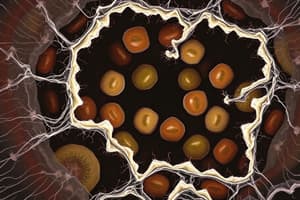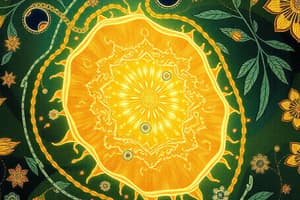Podcast
Questions and Answers
What do prokaryotic cells lack that eukaryotic cells possess?
What do prokaryotic cells lack that eukaryotic cells possess?
- Mitochondria
- Nucleus (correct)
- Ribosomes
- Endoplasmic reticulum
Which organelle is primarily responsible for ATP production?
Which organelle is primarily responsible for ATP production?
- Nucleus
- Mitochondria (correct)
- Golgi apparatus
- Endoplasmic reticulum
What is the main function of the Golgi apparatus?
What is the main function of the Golgi apparatus?
- Modification and packaging of proteins (correct)
- Protein synthesis
- DNA storage
- Energy production
Which of the following describes passive transport?
Which of the following describes passive transport?
What occurs during glycolysis?
What occurs during glycolysis?
Which biological molecule serves as a primary source of energy?
Which biological molecule serves as a primary source of energy?
The sodium-potassium pump is an example of which type of transport?
The sodium-potassium pump is an example of which type of transport?
Lysosomes are important for which cellular function?
Lysosomes are important for which cellular function?
What is the primary function of genes?
What is the primary function of genes?
What best describes the central dogma of molecular biology?
What best describes the central dogma of molecular biology?
Which process exemplifies natural selection?
Which process exemplifies natural selection?
What is the role of chloroplasts in photosynthesis?
What is the role of chloroplasts in photosynthesis?
Which statement correctly describes feedback mechanisms in homeostasis?
Which statement correctly describes feedback mechanisms in homeostasis?
What best characterizes a biome?
What best characterizes a biome?
Which of the following accurately describes gene expression?
Which of the following accurately describes gene expression?
Which factor is critical for maintaining homeostasis?
Which factor is critical for maintaining homeostasis?
Flashcards
What are genes?
What are genes?
Genes are segments of DNA containing instructions for building proteins.
What is DNA replication?
What is DNA replication?
DNA replication copies DNA to ensure each new cell receives a complete set of genetic instructions.
What is the central dogma?
What is the central dogma?
The flow of genetic information from DNA to RNA to protein.
What is ecology?
What is ecology?
Signup and view all the flashcards
What is a population?
What is a population?
Signup and view all the flashcards
What is evolution?
What is evolution?
Signup and view all the flashcards
What is natural selection?
What is natural selection?
Signup and view all the flashcards
What is photosynthesis?
What is photosynthesis?
Signup and view all the flashcards
What are prokaryotic cells?
What are prokaryotic cells?
Signup and view all the flashcards
What are eukaryotic cells?
What are eukaryotic cells?
Signup and view all the flashcards
What is the nucleus?
What is the nucleus?
Signup and view all the flashcards
What are mitochondria?
What are mitochondria?
Signup and view all the flashcards
What is the cell membrane?
What is the cell membrane?
Signup and view all the flashcards
What is cellular respiration?
What is cellular respiration?
Signup and view all the flashcards
What are the four major classes of biological molecules?
What are the four major classes of biological molecules?
Signup and view all the flashcards
Study Notes
Cell Structure and Function
- Cells are the basic units of life, exhibiting a wide variety of shapes and sizes.
- Prokaryotic cells lack a nucleus and membrane-bound organelles, while eukaryotic cells have a nucleus and various organelles.
- Common eukaryotic organelles include the nucleus, mitochondria, endoplasmic reticulum (ER), Golgi apparatus, and lysosomes.
- The nucleus houses the cell's genetic material (DNA).
- Mitochondria are the powerhouses of the cell, generating ATP through cellular respiration.
- The endoplasmic reticulum is involved in protein synthesis and lipid metabolism.
- The Golgi apparatus modifies, sorts, and packages proteins.
- Lysosomes contain digestive enzymes for breaking down waste materials.
Cell Membrane
- The cell membrane is a selectively permeable barrier controlling substance passage.
- It's primarily a phospholipid bilayer with embedded proteins.
- The phospholipid bilayer creates a hydrophobic barrier regulating molecule movement.
- Membrane proteins facilitate substance transport (ions, nutrients, waste).
- Passive transport (diffusion, osmosis) doesn't require energy.
- Active transport (sodium-potassium pump) needs energy to move substances against their concentration gradient.
Cellular Respiration
- Cellular respiration breaks down glucose to release energy as ATP.
- It occurs in three stages: glycolysis, the Krebs cycle, and the electron transport chain.
- Glycolysis happens in the cytoplasm, breaking glucose into pyruvate.
- The Krebs cycle (citric acid cycle) occurs in the mitochondria, further oxidizing pyruvate.
- The electron transport chain, also in the mitochondria, creates a large amount of ATP through electron transfer.
Biological Molecules
- The four main biological molecules are carbohydrates, lipids, proteins, and nucleic acids.
- Carbohydrates (composed of C, H, and O) are a primary energy source.
- Lipids are diverse hydrophobic molecules (fats, oils, steroids).
- Proteins (amino acid polymers) have diverse functions (structure, catalysis).
- Nucleic acids (DNA, RNA) store and transmit genetic information.
Genetics
- Genes are DNA segments coding for protein production.
- DNA replication copies DNA to ensure each new cell has a complete set of genetic instructions.
- Gene expression involves DNA transcription into RNA and RNA translation into protein.
- Mutations are DNA sequence changes impacting traits.
- The central dogma describes the flow of genetic information (DNA to RNA to protein).
Ecology
- Ecology studies organism-environment interactions.
- Ecosystems have biotic (living) and abiotic (non-living) components.
- Food webs depict energy flow in ecosystems.
- Populations are groups of the same species in an area.
- Communities are groups of different populations interacting.
- Biomes are large ecosystems with unique climates and vegetation.
Evolution
- Evolution is change in heritable characteristics over generations.
- Natural selection favors advantageous traits for survival and reproduction.
- Genetic drift is a random change in allele frequencies.
- Speciation is the formation of new species.
- Fossil records, comparative anatomy, and molecular biology support evolution.
Photosynthesis
- Photosynthesis converts light energy to chemical energy in plants.
- It converts carbon dioxide and water into glucose and oxygen.
- Photosynthesis occurs in chloroplasts, specifically the thylakoid membranes.
- Light-dependent reactions capture light, producing ATP and NADPH.
- Light-independent reactions use ATP and NADPH to form glucose from carbon dioxide.
Homeostasis
- Homeostasis maintains stable internal conditions.
- It involves temperature, pH, and other physiological regulation.
- Feedback mechanisms are crucial for maintaining homeostasis.
- Negative feedback loops counter changes; positive feedback loops amplify them.
Studying That Suits You
Use AI to generate personalized quizzes and flashcards to suit your learning preferences.




